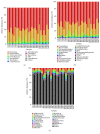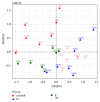Zearalenone Changes the Diversity and Composition of Caecum Microbiota in Weaned Rabbit
- PMID: 30402473
- PMCID: PMC6196994
- DOI: 10.1155/2018/3623274
Zearalenone Changes the Diversity and Composition of Caecum Microbiota in Weaned Rabbit
Abstract
Mycotoxins exhibit several severe effects on intestinal health, but few studies have assessed mycotoxins effect on the intestinal microflora and its repercussions to humans and animals. In this study, we evaluated the effect of zearalenone (ZEA), one of the most harmful mycotoxins on the structure of caecal microbiota in rabbits. Twenty-eight male weaned rabbits were randomly divided into four groups and orally given different concentrations of ZEA (400, 800, and 1600 μg/kg.b.w). Microbial communities in caecum samples of rabbits were analyzed for 16S rRNA by Illumina sequencing through Illumina Miseq platform after being fed for 28 days. The results showed that increasing ZEA doses increased the species richness but did not significantly increased the species diversity of the caecum microbiota in the rabbits. In addition, the caecum microbiota from the samples in different ZEA-treated groups was clustered according to their dosing regimens. At the phylum level, ZEA decreased the abundance of Actinobacteria and significantly increased the abundance of Cyanobacteria, Synergistetes, and Proteobacteria. At the genus level, there were declines in the abundance of Adlercreutzia, Blautia, Desulfitobacter, Lactobacillus, Oxalobacter, and p-75-a5. The decrease of abundance in Lactobacillus, Desulfitobacter, and p-75-a5 was particularly noticeable. In conclusion, zearalenone could increase α-diversity but significantly decrease the abundance of some bacteria with the important metabolic functions. These findings suggested that ZEA could modify the caecum microbiota.
Figures









Similar articles
-
Impact of dietary fiber/starch ratio in shaping caecal microbiota in rabbits.Can J Microbiol. 2015 Oct;61(10):771-84. doi: 10.1139/cjm-2015-0201. Epub 2015 Aug 4. Can J Microbiol. 2015. PMID: 26361938
-
Illumina Miseq platform analysis caecum bacterial communities of rex rabbits fed with different antibiotics.AMB Express. 2016 Dec;6(1):100. doi: 10.1186/s13568-016-0273-1. Epub 2016 Oct 21. AMB Express. 2016. PMID: 27770389 Free PMC article.
-
Impact of a probiotic, inulin, or their combination on the piglets' microbiota at different intestinal locations.Benef Microbes. 2015;6(4):473-83. doi: 10.3920/BM2014.0030. Epub 2015 Feb 12. Benef Microbes. 2015. PMID: 25380797
-
Understanding the mechanisms of zinc bacitracin and avilamycin on animal production: linking gut microbiota and growth performance in chickens.Appl Microbiol Biotechnol. 2017 Jun;101(11):4547-4559. doi: 10.1007/s00253-017-8193-9. Epub 2017 Feb 28. Appl Microbiol Biotechnol. 2017. PMID: 28243710
-
Impact of mycotoxins on the intestine: are mucus and microbiota new targets?J Toxicol Environ Health B Crit Rev. 2017;20(5):249-275. doi: 10.1080/10937404.2017.1326071. Epub 2017 Jun 21. J Toxicol Environ Health B Crit Rev. 2017. PMID: 28636450 Review.
Cited by
-
Gut-Faecal Microbial and Health-Marker Response to Dietary Fumonisins in Weaned Pigs.Toxins (Basel). 2023 May 11;15(5):328. doi: 10.3390/toxins15050328. Toxins (Basel). 2023. PMID: 37235363 Free PMC article.
-
Dynamic distribution of gut microbiota in meat rabbits at different growth stages and relationship with average daily gain (ADG).BMC Microbiol. 2020 May 14;20(1):116. doi: 10.1186/s12866-020-01797-5. BMC Microbiol. 2020. PMID: 32410629 Free PMC article.
-
Astaxanthin Alleviates Ochratoxin A-Induced Cecum Injury and Inflammation in Mice by Regulating the Diversity of Cecal Microbiota and TLR4/MyD88/NF-κB Signaling Pathway.Oxid Med Cell Longev. 2021 Jan 5;2021:8894491. doi: 10.1155/2021/8894491. eCollection 2021. Oxid Med Cell Longev. 2021. PMID: 33505592 Free PMC article.
-
Gut Microbiome-Based Diagnostic Model to Predict Diabetes Mellitus.Bioengineered. 2021 Dec;12(2):12521-12534. doi: 10.1080/21655979.2021.2009752. Bioengineered. 2021. PMID: 34927535 Free PMC article.
-
Gut Microbiota Characterization in Patients with Asymptomatic Hyperuricemia: probiotics increased.Bioengineered. 2021 Dec;12(1):7263-7275. doi: 10.1080/21655979.2021.1976897. Bioengineered. 2021. PMID: 34590550 Free PMC article.
References
MeSH terms
Substances
LinkOut - more resources
Full Text Sources

